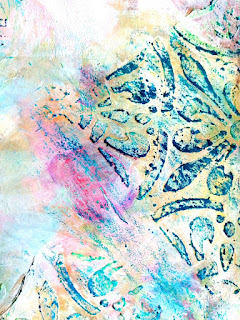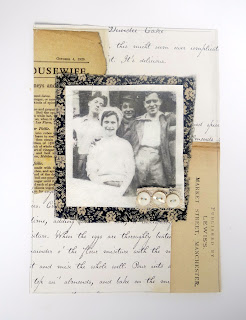There are so many ways to add beautiful and interesting textures to your mixed media work! In this tutorial I'll show you some methods using materials you probably already have around the house.
1. Tissue Paper
This technique works with any sort of tissue paper - even loo roll! Simply crumple up the sheet of tissue and glue it to your paper or canvas. Let it crease as much as you want; the more creases, the more lovely texture!
Once dried, the paper can be painted over. Rubbing a dry medium (e.g. pastels/coloured pencils/charcoal) over the top will bring out the texture even more.
2. Glue
Pour and drip PVA glue from the bottle, making random shapes and patterns. Once it's dry (this can take a while depending how thick your glue is) it can be painted over.
3. Texture paste and stencils
OK, so for the below examples I have used a commercial stencil and texture paste (Galeria modelling paste by Windsor and Newton, if you're interested).
But if you don't have these supplies on hand, you could try making a homemade 'texture paste' using flour with a little water added. You can also make a DIY stencil by cutting shapes out of cardboard packaging.
On these 2 canvases I applied a layer of texture paste, then pressed bubble wrap and lace into it whilst it was still wet. I also made some marks into the wet paste with a palette knife.
The picture below is with paint added (zoom in to see the textural effects).
The example below was done on an old painting that I'd started, but wasn't keen on. I laid my stencil on top then pushed texture paste through the holes with an old bank card.
Once the paste was dry I added more paint, then gently rubbed an oil pastel over the surface to define the raised areas.


4. Adding ephemera
There are so many possibilities with this one! Keep an open mind and consider trying anything that could give an unusual texture - eggshells, string, corrugated card...
With this little canvas I glued down fragments of skeleton leaves on to the bottom part, before painting...
...and the mixed media collage below includes an old book spine and 3 rusty washers (nothing goes to waste in my house!)
5. Fabric
Glued on fabric can give some lovely effects. And it doesn't have to be applied flat - I love folds and frayed edges! For the piece on the left I've tried to create little ripples as I was gluing the fabric strip down.
And here they are painted...


6. Scratching into paint
Finally, I love the texture that scratching into a painted surface gives. In this painting I've used a nail to scratch into the paint...
... for this one, I used the tip of a compass...
This effect can be as subtle or intense as you like (depending on what you're scratching into of course - bear in mind that wood will take much more punishment than paper!)
I hope you've enjoyed these ideas. If you try any of them I'd love to see your work!
Stay creative, safe and well :-)



































